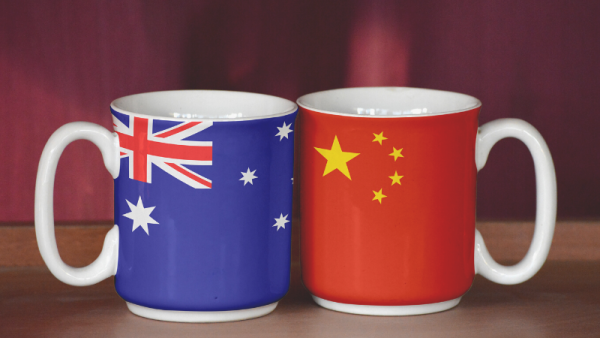Aritra Deb / Shutterstock

Kevin Magee, Adjunct Fellow, Australia-China Relations Institute, University of Technology Sydney |
Perspectives is UTS:ACRI's commentary series, featuring a piece on a topical subject in the Australia-China relationship from an invited expert contributor.
Australian Prime Minister Anthony Albanese’s November trip to the People’s Republic of China (PRC) has been heralded by both nations as a positive visit.
Beijing used its traditional protocol style to welcome Albanese, scheduling meetings with President Xi Jinping, Premier Li Qiang and National People’s Congress Chairman Zhao Leji, although Albanese was only one of four international leaders Xi met that day. On the Australian side, there was some indulgence in nostalgia about the 50th anniversary of Gough Whitlam’s historic visit.
The visit, a long time coming, was able to proceed due to a change of narrative and rhetoric and a series of concessions from both sides from mid-2022 onwards. Both countries, holding the view that it was in their national interest to repair relations to a degree, took steps to clear the way for a visit once the narrative changed and diplomacy rather than antagonism entered centre stage.
The PRC insisted that that Canberra should not set any ‘preconditions’ for Albanese’s visit and Australia, in its management of messaging around the visit, appeared to agree. Nonetheless, Beijing released Cheng Lei, an Australian citizen detained by the PRC for over three years, eased some of its trade sanctions on Australian goods and agreed to review its duties on Australian wine. Canberra did not cancel the Port of Darwin’s 99-year lease held by PRC company Landbridge, eschewed Magnitsky sanctions against PRC officials and entities involved in human rights violations in Xinjiang and Hong Kong. It also used careful language about Taiwan and the PRC’s human rights record. Additionally, Australia eased its outright opposition to PRC membership of the Comprehensive and Progressive Agreement for Trans-Pacific Partnership (CPTPP) while still setting a high bar and casting doubt on its support for Taiwan’s CPTPP membership.
Engagement and dialogue became the new agreed goals of both sides. Beijing’s ‘wolf warrior’ rhetoric was gone as was the overt antipathy to the PRC that firmly took root during Scott Morrison’s prime ministership. Australia had reached the goal, set by the Albanese government on its election, of ‘stabilising’ the relationship with the PRC.
However, one thing did not change from the Morrison era and within this is contained the seeds for future tension and damage to the bilateral relationship: There was to be no compromise on national security.
The Australian Labor Party without serious debate either in parliament or in broader society adopted in its entirety the Morrison recipe of AUKUS, support for US primacy and a narrative emphasising the PRC threat. This was reflected in its widely questioned Defence Strategic Review report, released in April. Much has been written about the PRC threat but no one in defence, the media or government can enunciate the direct military threat to Australia posed by the PRC now, nor in the future. It appears the threat is the potential for PRC to displace the US as the dominant political and military hegemon in the region – something that gives the national security establishment nightmares.
The breakdown of trust between the two countries has been well-explored. This has come about by the actions of both countries. The PRC’s cyber-attacks, trade sanctions and its detention of Australian citizens has undermined trust, as has its continued destabilising actions in the South China Sea. On the other hand, Australia has abandoned the policy of balancing trade and national security that marked the success of its PRC policy from the 1980s and has firmly sided US in treating the PRC as strategic competitor. In Beijing’s eyes, Canberra’s rejection of Huawei in its 5G rollout, its sudden call for an inquiry into the origins of COVID-19 and its restrictions on investment clearly directed at the PRC, as well as the AUKUS security partnership and the Quad, have also undermined trust.
The Albanese government has categorised its PRC policy as ‘stabilisation of the relationship’, not a reset or return to pre-2016 policy settings. An Asia Society analyst recently wrote that stabilisation was the only option for the relationship and blamed the limit on improving the relationship beyond stabilisation solely on Xi’s aggressive policies. This is true to a degree but Canberra has also chosen to limit itself its options with Beijing. The Australian government knows it can’t achieve better than stabilising the relationship while it takes the path that suggests the nation’s essential trading partner is a military threat and adversary that must be met with an ‘impactful projection of a long range strike’ capability, nuclear submarines, the Quad and more. This is the fundamental contradiction that undermines the long-term relationship between Australia and the PRC despite the diplomatic niceties of the Albanese visit to Beijing.
The question must be asked, therefore, is ‘stabilisation’ of the relationship enough for Australia?
The long-term cost to Australia of not building a firmer non-antagonistic relationship with the PRC has not been calculated yet, but it could be steep. Stabilising the relationship and engaging in as a partisan player on one side in a competition as the struggle between the US and the PRC heats up arguably leads to more long-term instability. By going down this path, the Albanese government has ensured that the PRC relationship cannot reach the highest potential for trade and economy and potentially draws Australia into a future conflict not of its own making.
Author
Kevin Magee is an Adjunct Fellow at the Australia-China Relations Institute, University of Technology Sydney.


